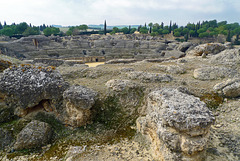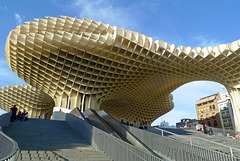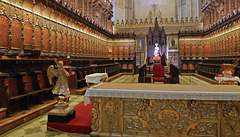
Andalucía - Andalusia
Spain – Málaga
| |
|
|
|
Pictures are taken along a rather steep and winding path and the scenic Paseo Don Juan de Temboury from the Gibralfaro Castle towards the Alcazaba, nearby the city centre of Málaga.
Spain - Málaga, Catedral de la Encarnación
| |
|
|
|
Malaga’s cathedral ‘Nuestra Señora de la Encarnación’ (Our Lady of Incarnation) was built between 1528 and 1782 on the plot of land of the former Almohad mosque. As a matter of fact it is still unfinished as the planned south tower was never built. The missing tower gives the cathedral its nickname ‘La Manquita’ (One Armed Lady).
The emblematic north tower has a height of 84 metres, making this building the second-highest cathedral in Andalusia. The rectangular built cathedral has a nave and two aisles, the former being wider, though having the same height - almost 42 metres - as the aisles.
The façade of the cathedral with its ornate stonework, unlike the rest of the building, is in baroque style and is divided into two levels; on the lower level are three arches, inside of which are portals separated by marble columns. Above the doors are medallions carved in stone (PiP).
For information and pictures of the interior: www.ipernity.com/doc/294067/41333332
Spain - Málaga, Catedral de la Encarnación
| |
|
|
|
Malaga’s cathedral ‘Nuestra Señora de la Encarnación’ (Our Lady of Incarnation) was built between 1528 and 1782 is one of the best examples of Spanish religious art. The interior of this impressive building shows influences of renaissance and baroque styles.
The cathedral offers a series of artworks, among them are the main altar with an elaborate marble pulpit on both sides (main picture). There are several side altars with the neoclassic altarpieces of the Chapel of the Incarnation (PiP 1) and the Chapel of the Sacred Heart (PiP 2). The choir has 42 beautifully carved stalls of mahogany and cedar wood (PiP 3). Above the stalls are two magnificent organs with more than 4.000 pipes, examples of 18th century musical instruments.
For information and pictures of the exterior: www.ipernity.com/doc/294067/41359686
Spain - Andalucia, Puerto del Viento
| |
|
|
|
Puerto del Viento (Wind Pass) is a pass on the road A-366 between Ronda and El Burgo on an altitude of 1.190 metres. The pass is located in the Serrania de Ronda/Sierra de los Merinos.
Spain - Ronda, Santa María la Mayor
| |
|
|
|
Without doubt the Iglesia de Santa María la Mayor is one of the most important religious buildings of Ronda. It was considered as a kind of cathedral, according to the founding documents.
In 1485 - after the conquest of the city from the Moors - the catholic monarchs ordered the building of the church at the place of the mosque. During the constructing there were and it was not finished until the end of the 17th century. This explains the combination of different styles of the church: a part of the former Moorish Mirhab, gothic columns in the three naves, a renaissance choir and ends with some baroque elements.
A central cedar choir screen divides the church into two sections: aristocrats to the front, everyone else at the back. The rear of this choir screen (main picture) is centering Our Lady of Peace surrounded by 14 elaborate wood carved renaissance reliefs.
The exterior of the church (PiP) has some beautiful balconies, built during the regime of Felip II. These were used by local authorities and aristocracy for watching knight games, bull fighting and other public acts on the square in front of the building.
Spain - Ronda, Puente Nuevo
| |
|
|
|
Puente Nuevo (New Bridge) is the second one on this place, replacing a bridge designed by King Philip V. When that bridge collapsed some years later (1751) started the construction of a new bridge, which took more than 40 years and was opened in 1793.
Puente Nuevo is the newest and largest of three bridges that span the 120-metre deep canyon of the Rio Guadalevín dividing the city of Ronda. The oldest one is dating back to 1616 and nowadays carries only pedestrians.
Puente Nuovo is 98 metres tall and is built in three levels. The bottom level has a single arch, the second level has one tall central arch and the top level has a central room and two shorter side arches. The impressive bridge has been built with stone masonry from the bottom of the gorge.
Nowadays Puente Nuevo can be considered as the landmark of Ronda.
Spain - Andalusia, San Luis de Sabinillas
| |
|
|
|
San Luis de Sabinillas was originally a fishing village, developing over the past hundred years. As in almost all Spanish fishing villages not much importance was attached to aesthetics and architecture and the old town is a jumble of structures.
Like most places along the Costa del Sol the village has grown rapidly over the last decade and lives more from tourism than from fishing. Sabinillas has a relatively authentic feel and has probably one of the few boulevards and beaches not spoiled by huge and ugly buildings.
Spain - Andalusia, Vejer de la Frontera
| |
|
|
|
Plaza de España - the main square - with a colourful tiled fountain, featuring four frogs.
The square is dating back to 16th century, when the town grew beyond its walls. During the 16th and 17th centuries, it was used for watching bull fights. In 1957 the fountain was built in the centre of the square, made of hand painted Sevillian tiles. Since then this square is popularly known as ‘Plaza de los Pescaítos’.
Spain - Andalusia, Vejer de la Frontera
| |
|
|
|
One of the four windmills in the neighbourhood of San Miguel, just outside Vejer. The mills were constructed to mill flour. The silhouette of these windmills is one of the symbols of the town and they have been preserved as a part of the history of Vejer.
Spain - Barbate, Torre del Tajo
| |
|
|
|
Torre del Tajo is a 16th century watchtower, which was built as part of a coastal defensive system along the Costa da Luz, the most southern part of Andalucía. Watchkeepers could warn for Moorish pirate attacks either by lighting a fire or sending smoke signals to neighbouring towers.
This 14 meters high tower is perched on a cliff 100 meters above the Atlantic Ocean. From the terrace of the Torre del Tajo one can enjoy magnificent views of the coast or even the African continent.
Torre de Tajo (Tower on the Edge) is located in the ‘Parque Natural de la Breña y Marismas del Barbate’, between Barbate and Caños de Meca. The national park is famous for its numerous umbrella pines.
Spain - Cádiz Cathedral
| |
|
|
|
Cádiz Cathedral is the most famous landmarks of the city. The church is built on the site of an older cathedral - completed in 1260 - which burned down in 1596. The new cathedral was built between 1722 and 1838. Construction began in the baroque style and was completed in the neoclassical style.
The cathedral is topped by a 52 m. high ‘golden’ dome, which adds a Moorish feel to the building.
The western bell tower (Torre de Poniente) has become a tourist attraction. The tower, whose construction began in Cadiz’s golden age in the 18th century, can be reached via the ramp. The top of the tower affords outstanding views over the city and a closer look at the dome.
Spain - Andalusia, Sanlúcar de Barrameda
| |
|
|
|
Beach along the Rio Guadalquivir in Sanlúcar de Barrameda; a well known sherry producing town. At the other side of the river lies Doñana National Park.
Spain - Santiponce, Italica
| |
|
|
|
The city of Italica - just outside the town of Santiponce and less than 10 km’s northwest of Sevilla - was founded in 206 BC by the Roman general Scipio in order to settle Roman soldiers, who were wounded in the Battle of Ilipa.
Italica was one of the earliest Roman settlements in Spain and was the birthplace of two emperors: Trajan and his adopted son Hadrian (from the wall across England).
Italica is divided into two areas: ‘Vetus Urbs’ (old city), which lies under the centre of Santiponce, and ‘Nova Urbs (new city), created by Hadrian as an extension of the existing town. Hadrian added temples, and rebuilt public buildings. Italica’s amphitheater seated 25,000 spectators and was the third largest in the Roman Empire. The city's population at the time is estimated to have been only 8000.
The excavation of Italica began mid 18th century and still continues. Following extensive excavations and the building of visitor facilities, Italica is now a popular destination for tourists, offering the amphitheater and remains of the city with paved roads and some stunning floor mosaics.
Spain - Sevilla, Metropol Parasol
| |
|
|
|
Metropol Parasol is a wooden structure, designed by the German architect Jürgen Mayer-Hermann and was completed in April 2011. The innovative structure is made from bonded timber with a polyurethane coating.
With its dimensions of 150 by 70 metres and a height of 26 metres it is considered being the largest timber-framed structure in the world. The Metropol Parasol is popularly known as ‘Las Setas’ (the Mushrooms).
The structure consists of six parasols in the form of giant mushrooms. The panoramic terraces and a short rooftop promenade offer visitors one of the best views of Sevilla.
Spain - Sevilla, Plaza de España
| |
|
|
|
Plaza de España is located in the Parque de María Luisa. It is one of the architectural landmarks of Sevilla. The semi-circular building was built for the Ibero-American Exposition of 1929 and was the central office. Architect Aníbal González mixed a style inspired by the renaissance with typical elements from the city: exposed brick, ceramics and wrought iron.
Plaza de España has a diametre of 200 metres and is flanked by two tall towers (PiP 1). In front of the building, following the curve of its façade, is a 500-metre canal crossed by four bridges, representing the four ancient kingdoms of Spain
Along the wall of the main building are 58 alcoves with benches, one for each province of Spain, each with a relevant tableau and map, all designed on colourful tiles (PiP 2 and 3).
Spain - Sevilla, Iglesia del Salvador
| |
|
|
|
Iglesia del Salvador (Salvador Church) is built on the remains of the 9th century Ibn Adabbas Mosque, the main mosque of Sevilla. When Christians conquered Seville, they allowed initially use as a mosque, but in 1340 it was converted into the parish church of Salvador, which lasted till 1671, when the building was quite deteriorated.
Construction of the present church started in 1674 and was fished in 1712. It has a basic structure with three naves and is the second largest church of Sevilla, after the cathedral.
The main altarpiece (PiP) from late 18th century is an absolute highlight in the exuberant interior of the church; it is considered to be one of the most monumental and representative works of the baroque style in Sevilla.
The plaza in front of the church, Plaza del Salvador, provides a popular meeting place and destination for both locals and visitors.
Spain - La Catedral de Sevilla
| |
|
|
|
‘La Catedral de Sevilla’ (or ofiicially‘Catedral de Santa María de la Sede’) has a lenght of 126 metres and a width of 83 metres. Its maximum height in the centre of the transept is 37 metres. The total surface of the building is 23.500 square metres. Measured by area Seville Cathedral is the largest Gothic cathedral and the third-largest church all over the world.
The cathedral is built on the site of Seville’s main mosque. This Almohad Mosque was consecrated as a cathedral in the year of 1248. The construction of thee Gothic cathedral began in 1434 and was finished early 16th century. Seville's cathedral was built to demonstrate the power and wealth of the city after the Reconquista.
The huge interior of the cathedral, with a central nave and four side aisles, is richly decorated. It also contains the tomb of Christopher Columbus. In the center of the church is the choir (main picture), which has elaborate 15th-century choir stalls.
Seville Cathedral was designated a World Heritage Site by UNESCO in 1987.
Spain - Sevilla, Real Alcázar
| |
|
|
|
The Real Alcázar Palace has the largest late-medieval garden in Europe, offering one of the most beautiful examples of royal Spanish palace grounds. The garden is an original representation of the typical Mudéjar style, a Muslim artistic expression adapted by the Christian world. Glazed and unglazed tiles and many features, like water channels, glittering pools, fountains and water spouts give this green oasis a special character.
During the 16th century - when Seville was the richest city in Spain - changes were made. The old garden spaces survived, but Charles V's designers were influenced by Renaissance styles when making a large labyrinth and a fine pavilion. A new garden was made in the early 20th century.
Nowadays the large garden area is divided into several separate parts in all kinds of styles, like French, Italian and Arabic. The garden of Real Alcázar has more than 170 different species of plants and trees, like palm, cypress, myrtle, mulberries, magnolia, orange, almond and lemon trees.
Jump to top
RSS feed- Latest items - Subscribe to the latest items added to this album
- ipernity © 2007-2024
- Help & Contact
|
Club news
|
About ipernity
|
History |
ipernity Club & Prices |
Guide of good conduct
Donate | Group guidelines | Privacy policy | Terms of use | Statutes | In memoria -
Facebook
Twitter


















